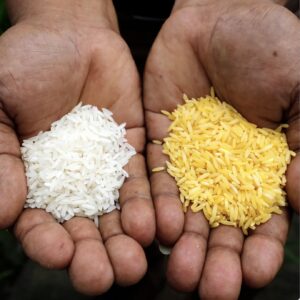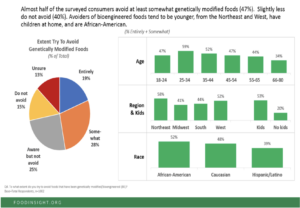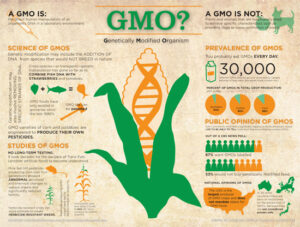Before eating anything, have you ever stopped to wonder what the food is made of, how it was created, what toxins it may include, or how it will affect your body? In conjunction with the inevitable passage of time, a plethora of different forms of technology has been rapidly developed. Technology has saturated several aspects of human life, evolving the pace and nature of the modern world, which consequently benefits the people inhabiting Earth; however, many controversies and disputes have arisen regarding the adverse impacts that are generated. A vital example of a recently developed form of technology is the introduction of genetically modified organisms (GMOs). GMOs are living organisms whose genetic material has been artificially manipulated in a laboratory through genetic engineering in order to achieve the expression of desired physiological traits or the production of desired biological traits. Within the history of modern agriculture, the implementation of GMOs is the most expeditiously practiced type of crop technology. However, there are ongoing debates amongst individuals on whether GMOs are helpful, or harmful.
Aforementioned, a genetically modified organism (GMO) is an organism or microorganism whose genetic material has been altered to contain a segment of DNA from another organism. The recent evolution of DNA technology allows for the “binding” ofpieces of DNA, regardless of the source of the pieces. This technology has been used extensively in the lab since the 1980s by researchers for countless purposes to make copies of genes or proteins, to determine gene function, to study gene expression patterns, and to create models for human disease. Crops such as corn, canola, soybean, and cotton make up the vast majority of genetically modified crops.
ofpieces of DNA, regardless of the source of the pieces. This technology has been used extensively in the lab since the 1980s by researchers for countless purposes to make copies of genes or proteins, to determine gene function, to study gene expression patterns, and to create models for human disease. Crops such as corn, canola, soybean, and cotton make up the vast majority of genetically modified crops.
Although most individuals believe genetically modified organisms (GMOs) are safe to consume, others argue that there are many ethical issues/concerns to take in. In a report done on GMOs, “Five sets of ethical concerns have been raised about GM crops: potential harm to human health; potential damage to the environment; negative impact on traditional farming practice; excessive corporate dominance; and the ‘unnaturalness’ of the technology” (Weale). Similar to these issues is the case of Henrietta Lacks, an African American woman whose cells were taken without her consent and used on the Hela cell line. Since then her cells have helped extensively in medical research, however, the way this occurred was extremely unethical. In both situations, one major ethical issue is with the corporations involved, and the disclosure  As stated in the text, “Several things happened to Ms. Lacks: Her cells were taken without her consent for clinical reasons, and then used for research, and shared with countless other scientists. Her genes, and thus those shared by her family members, were published, in association with her name” (Klitzman). This quote expresses the dominance large corporations have as they were able to get away with taking Lacks cells without her consent and profiting off this research. Similarly, with genetically modified organisms (GMOs) there are a few big corporate companies that control the foods that are genetically modified and are able to get away with all the profit. Regarding disclosure, in both cases, we see the lack of sharing information. As for GMOs, audiences lack data on what they’re made of, whilst Lacks, her family, and everyone else were unaware of how her cells were being used. This is caused by technology, due to the fact that it is constantly evolving and allowing for individuals to get away with these things.
As stated in the text, “Several things happened to Ms. Lacks: Her cells were taken without her consent for clinical reasons, and then used for research, and shared with countless other scientists. Her genes, and thus those shared by her family members, were published, in association with her name” (Klitzman). This quote expresses the dominance large corporations have as they were able to get away with taking Lacks cells without her consent and profiting off this research. Similarly, with genetically modified organisms (GMOs) there are a few big corporate companies that control the foods that are genetically modified and are able to get away with all the profit. Regarding disclosure, in both cases, we see the lack of sharing information. As for GMOs, audiences lack data on what they’re made of, whilst Lacks, her family, and everyone else were unaware of how her cells were being used. This is caused by technology, due to the fact that it is constantly evolving and allowing for individuals to get away with these things.
Although genetically modified organisms (GMOs) aren’t necessarily an issue for some ethnic groups with histories of racism, language, religious, or cultural bias, it is a topic that concerns everyone in a similar way. GMOs are being put into a wide number of foods that we consume every day, and most of the time we don’t acknowledge this. One way this issue can be resolved is through labeling. Foods should be labeled (with images) either GMO or non-GMO because there are people who may want to avoid consuming GMOs altogether. In most supermarkets, there are no stickers on fruits labeling it GMO or non-GMO, there are only signs labeling the “organic” fruits, and this may not be enough for people who speak/understand another language. This is an issue that concerns everyone as individuals should be aware of what they are feeding into their bodies, along with the pros and cons.
Despite these criticisms, others have found genetically modified organisms (GMOs) to be extremely helpful and beneficial. Supporters of GMOs found that GMOs have progressed the fundamentals of animal feed. The research found, “It is estimated that 70-90% of GM crop biomass has been consumed by multiple generations of food-producing animals for the past 20 years,” (Young). Over this span of time, numerous generations have been advancing and no deleterious, harmful or damaging, effects have been shown. In fact, genetically modified animal feed is actually beneficial for wildlife. An example of this would be genetically modified corn. As stated, “Already, most corn and soy in the U.S. is genetically modified to be more resistant to pests and herbicides. But as genetically modified salmon make their way to dinner plates, the pace of change to the food supply could accelerate” (Associated Press). Another positive is that the utilization of genetically modified organisms can decrease the presence of poverty for many people. As more farmers adopt the practice of GMOs, they will be able to profit more for themselves, which will allow them to live their lives properly and not in penury. The farmers will not have to deal with the dilemmas that arise from not possessing sufficient money to even provide for themselves and their families. Along with that, “GMO crops allow farmers to produce affordable food by using less land, water, and pesticides,” (“Thank genetic modification for low American food prices”). Farmers are given the opportunity to use less to produce the same amount of food for people. The food that is produced by the farmers will also become a more reasonable price for people to purchase. As a result, people are given cheaper food options to both buy and sell, expanding the availability and diversity of food for everyone.
generations have been advancing and no deleterious, harmful or damaging, effects have been shown. In fact, genetically modified animal feed is actually beneficial for wildlife. An example of this would be genetically modified corn. As stated, “Already, most corn and soy in the U.S. is genetically modified to be more resistant to pests and herbicides. But as genetically modified salmon make their way to dinner plates, the pace of change to the food supply could accelerate” (Associated Press). Another positive is that the utilization of genetically modified organisms can decrease the presence of poverty for many people. As more farmers adopt the practice of GMOs, they will be able to profit more for themselves, which will allow them to live their lives properly and not in penury. The farmers will not have to deal with the dilemmas that arise from not possessing sufficient money to even provide for themselves and their families. Along with that, “GMO crops allow farmers to produce affordable food by using less land, water, and pesticides,” (“Thank genetic modification for low American food prices”). Farmers are given the opportunity to use less to produce the same amount of food for people. The food that is produced by the farmers will also become a more reasonable price for people to purchase. As a result, people are given cheaper food options to both buy and sell, expanding the availability and diversity of food for everyone.
To conclude, GMOs are continuing to grow and becoming used on much more than just crops and animals. The introduction of GMOs has indeed been proven beneficial with it bettering food provided to animals and minimizing the penury that exists. However, there are still some major ethical issues such as the effect on the environment and individuals that consume genetically modified crops/organisms.
Work Cited
Acker, R. V., Rahman, M. M., & Cici, S. Z. H. (2017, October 26). Pros and cons of GMO crop farming. Oxford Research Encyclopedia of Environmental Science. Retrieved March 7, 2022, from https://oxfordre.com/environmentalscience/view/10.1093/acrefore/9780199389414.001.0001/acrefore-9780199389414-e-217
Chicago Sun-Times. (2019, April 18). Thank genetic modification for low American food prices. Times. Retrieved March 7, 2022, from https://chicago.suntimes.com/2016/6/24/18454847/thank-genetic-modification-for-low-american -food-prices
Klitzman, R. (2017, April 21). Should you worry about being the next henrietta lacks? The New York Times. Retrieved March 7, 2022, from https://www.nytimes.com/2017/04/21/well/should-you-worry-about-being-the-next-henrietta-lacks.html
Press, A. (2019, June 21). These are the first genetically modified animals approved for U.S. consumption. MarketWatch. Retrieved March 7, 2022, from https://www.marketwatch.com/story/the-first-genetically-modified-animals-approved-for-us-consumption-are-here-2019-06-21?link=sfmw_fb
Weale A. (2010). Ethical arguments relevant to the use of GM crops. New biotechnology, 27(5), 582–587. https://doi.org/10.1016/j.nbt.2010.08.013
Young, A. E., & Eenennaam, V. (2017, August 1). 733 Genetically engineered feed: Impact on animal performance, health and products. Academic.oup.com. Retrieved March 7, 2022, from https://academic.oup.com/jas/article-abstract/95/suppl_4/357/4765721?redirectedFrom=PDF

